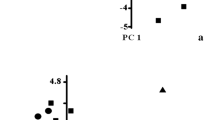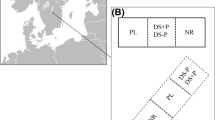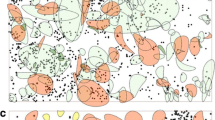Abstract
Traditional management of montado (dehesa) is an example of integration of sustainable land-use and biodiversity conservation. The whole system sustainability is currently threatened by the intensification of soil tilling to control shrub invasion and promote pastureland, the absence of tree natural regeneration being one of the most outstanding threats. A study to assess effects of management on tree regeneration at early stages was developed in a cork oak montado grazed by cattle, in southern Portugal. We specifically compared the effects of harrowing every 3–4 years with those of shrub clearing with a shredder every 5–7 years. We hypothesized that extending shrub maintenance may facilitate cork oak regeneration at early stages in grazed montado. Fenced cork oak paddocks under the same management system for at least the last 40 years were surveyed for cork oak seedling, juvenile and sapling density; shrub cover percentage was also estimated. Recruitment bottleneck was observed after the seedling stage under harrowing, while in shredded areas all stages were well represented and often associated with shrub patches. Overall, the highest cork oak recruitment occurred at intermediate shrub cover (40–60 %). By maintaining shrub patches and their protective effect against direct radiation and grazing impact, while preventing shrub encroachment, shredding every 7 years seems to create an important temporal window for effective oak regeneration. This management practice might thus be suitable to favour successful tree regeneration in grazed cork oak montado, assuring the persistence of this system.





Similar content being viewed by others
References
Acácio V, Holmgren M, Jansen PA, Schrotter O (2007) Multiple recruitment limitation causes arrested succession in Mediterranean cork oak systems. Ecosystems 10:1220–1230
Acácio V, Holmgren M, Rego F, Moreira F, Mohren GMJ (2009) Are drought and wildfires turning Mediterranean cork oak forest into persistent shrubland? Agrofor Syst 76:389–400
Blondel J, Aronson J (1999) Biology and wildlife of the Mediterranean region. Oxford University Press, New York
Bugalho MN, Lecomte X, Gonçalves M, Caldeira MC, Branco M (2011) Establishing grazing and grazing-excluded patches increases plant and invertebrate diversity in a Mediterranean oak woodland. Forest Ecol Manag 261:2133–2139
Caldeira MC, Ibáñez I, Nogueira C, Bugalho MN, Lecomte X, Moreira M, Pereira JS (2014) Direct and indirect effects of tree canopy facilitation in the recruitment of Mediterranean oaks. J Appl Ecol 51:349–358
Cardillo E, Bernal CJ (2006) Morphological response and growth of cork oak (Quercus suber L.) seedlings at different shade levels. Forest Ecol Manag 222:296–301
Carmona CP, Azcárate FM, Oteros-Rozas E, González JA, Peco B (2013) Assessing the effects of seasonal grazing on holm oak regeneration: Implications for the conservation of Mediterranean dehesas. Biol Conserv 159:240–247
Carvalhosa AB, Carvalho AMG, Alves CAM (1969) Notícia explicativa da folha 40-A—Évora da Carta Geológica de Portugal na escala de 1/50 000. Serviços Geológicos de Portugal, Lisboa
Cierjacks A, Hensen I (2004) Variation of stand structure and regeneration of Mediterranean holm oak along a grazing intensity gradient. Plant Ecol 173:215–223
Costa A, Madeira M, Oliveira ÂC (2008) The relationship between cork oak growth patterns and soil slope and drainage in a cork oak woodland in Southern Portugal. Forest Ecol Manag 255:1525–1535
David TS, Henriques MO, Kruz-Besson C, Nunes J, Valente F, Vaz M, Pereira JS, Siegwolf R, Chaves MM, Gazarini LC, David JS (2007) Water-use strategies in two co-occurring Mediterranean evergreen oaks: surviving the summer drought. Tree Physiol 27:793–803
DGRF (2007) Resultados do Inventário Florestal Nacional 2005/06. Inventário Florestal Nacional, Direcção-Geral dos Recursos Florestais, Lisboa
Eichhorn MP, Paris P, Herzog F, Incoll LD, Liagre F, Mantzanas K, Mayus M, Moreno G, Papanastasis VP, Pilbeam DJ, Pisanelli A, Dupraz C (2006) Silvoarable systems in Europe—past present and future prospects. Agrofor Syst 67:29–50
Eldridge DJ, Bowker MA, Maestre FT, Roger E, Reynolds JF, Whitford WG (2011) Impacts of shrub encroachment on ecosystem structure and functioning: towards a global synthesis. Ecol Lett 14:709–722
Espelta JM, Riba M, Javier R (1995) Patterns of seedling recruitment in West-Mediterranean Quercus ilex forest influenced by canopy development. J Veg Sci 6:465–472
Gómez-Aparicio L, Pérez-Ramos IM, Mendoza I, Quero JL, Matías L, Castro J, Zamora R, Marañón T (2008) Oak seedling survival and growth along resource gradients in Mediterranean forests: implications for regeneration under current and future environmental scenarios. Oikos 117:1683–1699
Howlett DS, Moreno G, Mosquera-Losada MR, Nair PKR, Nair VD (2011) Soil carbon storage as influenced by tree cover in the dehesa cork oak silvopasture of central-western Spain. J Environ Monit 13:1897–1904
Joffre R, Rambal S, Ratte JP (1999) The dehesa system of southern Spain and Portugal as a natural ecosystem mimic. Agrofor Syst 45:57–79
Maltez-Mouro S, García LV, Freitas H (2009) Influence of forest structure and environmental variables on recruit survival and performance of two Mediterranean tree species (Quercus faginea L. and Q suber Lam). Eur J For Res 128:27–36
McEvoy PM, McAdam JH, Mosquera-Losada MR, Rigueiro-Rodríguez A (2006) Tree regeneration and sapling damage of pedunculate oak Quercus robur in a grazed forest in Galicia NW Spain: a comparison of continuous and rotational grazing systems. Agrofor Syst 66:85–92
Moreno G, Obrador JJ (2007) Effects of trees and understory management on soil fertility and nutrient status of holm oaks in Spanish dehesas. Nutr Cycl Agroecosyst 78:253–264
Moreno G, Pulido F (2009) The functioning management and persistence of dehesas. In: Rigueiro A, McAdam J, Mosquera R (eds) Agroforestry in Europe. Springer, Amsterdam, pp 127–160
Olea L, San Miguel-Ayanz A (2006) The Spanish dehesa. A traditional Mediterranean silvopastoral system linking production and nature conservation. Grassland Sci Eur 11:3–13
Padilla FM, Miranda JD, Ortega R, Hervás M, Sánchez J, Pugnaire FI (2011) Does shelter enhance early seedling survival in dry environments? A test with eight Mediterranean species. Appl Veg Sci 14:31–39
Pausas JG, Ribeiro E, Dias SG, Pons J, Beseler C (2006) Regeneration of a marginal Cork oak (Quercus suber) forest in the eastern Iberian Peninsula. J Veg Sci 17:729–738
Pausas JG, Marañón T, Caldeira M, Pons J (2009) Natural regeneration. In: Aronson J, Pereira JS, Pausas JG (eds) Cork oak woodlands on the edge: ecology, adaptive management and restoration. Island, Washington, DC, pp 115–124
Pérez-Devesa M, Cortina J, Vilagrosa A, Vallejo R (2008) Shrubland management to promote Quercus suber L. establishment. For Ecol Manag 255:374–382
Pérez-Ramos IM, Zavala MA, Marañón T, Díaz-Villa MD, Valladares F (2008) Dynamics of understorey herbaceous plant diversity following shrub clearing of cork oak forests: a five-year study. For Ecol Manag 255:3242–3253
Pinto-Correia T (2000) Future development in Portuguese rural areas: how to manage agricultural support for landscape conservation? Landsc Urban Plan 50:95–106
Pinto-Correia T, Ribeiro N, Sá-Sousa P (2011) Introducing the montado, the cork and holm oak agroforestry system of Southern Portugal. Agrofor Syst 82:99–104
Plieninger T (2007) Compatibility of livestock grazing with stand regeneration in Mediterranean holm oak parklands. J Nat Conserv 15:1–9
Plieninger T, Pulido F, Konold W (2003) Effects of land-use history on size structure of holm oak stands in Spanish dehesas: implications for conservation and restoration. Environ Conserv 30:61–70
Plieninger T, Pulido FJ, Schaich H (2004) Effects of land-use and landscape structure on holm oak recruitment and regeneration at farm level in Quercus ilex L. dehesas. J Arid Environ 57:345–364
Plieninger T, Rolo V, Moreno G (2010) Large-scale patterns of Quercus ilex, Quercus suber and Quercus pyrenaica regeneration in central-western Spain. Ecosystems 13:644–660
Pons J, Pausas JG (2006) Oak regeneration in heterogeneous landscapes: the case of fragmented Quercus suber forests in the eastern Iberian Peninsula. For Ecol Manag 231:196–204
Pulido F, Díaz M (2005) Regeneration of a Mediterranean oak: a whole cycle approach. Ecoscience 12:92–102
Pulido FJ, Díaz M, Trucios SJH (2001) Size structure and regeneration of Spanish holm oak Quercus ilex forests and dehesas: effects of agroforestry use on their long-term sustainability. For Ecol Manag 146:1–13
Pulido F, García E, Obrador JJ, Moreno G (2010) Multiple pathways for tree regeneration in anthropogenic savannas: incorporating biotic and abiotic drivers into management schemes. J Appl Ecol 47:1272–1281
Ramírez JA, Díaz M (2008) The role of temporal shrub encroachment for the maintenance of Spanish holm oak (Quercus ilex) dehesas. For Ecol Manag 255:1976–1983
R Development Core Team (2009) R: a language and environment for statistical computing. R Foundation for Statistical Computing, Vienna. http://www.R-project.org. Accessed 20 April 2015
Ribeiro PF, Santos JL, Bugalho MN, Santana J, Reino L, Beja P, Moreira F (2014) Modelling farming system dynamics in high nature value farmland under policy change. Agric Ecosyst Environ 183:138–144
Rivas-Martínez S, Díaz TE, González FF, Izco J, Loidi J, Lousã M, Penas A (2002) Vascular plant communities of Spain and Portugal Addenda to the Syntaxonomical checklist of 2001. Itinera Geobotanica 15:5–922
Rivas-Martínez S, Penas A, Díaz TE (2004) Biogeographic and bioclimatic maps of Europe. Serviços Cartográficos da Universidad de León, León
Simón N, Montes F, Díaz-Pinés E, Benavides R, Roig S, Rubio A (2013) Spatial distribution of the soil organic carbon pool in a Holm oak dehesa in Spain. Plant Soil 366:537–549
Smit C, den Ouden J, Díaz M (2008) Facilitation of Quercus ilex recruitment by shrubs in Mediterranean open woodlands. J Veg Sci 19:193–200
WRB (2006) World reference base for soil resources. A framework for international classification correlation and communication, vol 103, 2nd edn., World soil reportsFAO, Rome
Acknowledgments
The authors are grateful to ‘Solar da Giesteira’ owners for permission to enter in the Torre da Giesteira state and for their continued support throughout this project. They also acknowledge the assistance of Drs. Ana Lumbreras and J. Tiago Marques in statistical analysis with R. This study was funded by FEDER Funds through the Operational Programme for Competitiveness Factors—COMPETE and National Funds through FCT—Foundation for Science and Technology under the Project PTDC/AGR-AAM/102369/2008 and the Strategic Project PEst-C/AGR/UI0115/2011.
Author information
Authors and Affiliations
Corresponding author
Rights and permissions
About this article
Cite this article
Simões, M.P., Belo, A.F., Fernandes, M. et al. Regeneration patterns of Quercus suber according to montado management systems. Agroforest Syst 90, 107–115 (2016). https://doi.org/10.1007/s10457-015-9818-6
Received:
Accepted:
Published:
Issue Date:
DOI: https://doi.org/10.1007/s10457-015-9818-6




